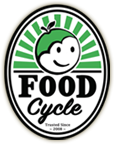It’s Friday afternoon and my first week at Marylebone FoodCycle is close to an end. As I write these words, upbeat music sets the tone at St. Paul’s Church, where Marylebone Food Cycle operates in joint collaboration. Not only a church but also a local community centre, St. Paul’s Church is constantly filled with a vibrant and diverse community, with events ranging from Nordic choirs and guitar lessons to Zumba classes and FoodCycle dinners. This has made St. Paul’s a place I would call home rather than a workplace. Located close to Church Street, it is a complete different London that I have come to experience so far, with a bustling street market and antique shops two steps away from Regent’s canal. A more ‘homy’ London is calling, away from the Georgian and Victorian South Kensington.
But let me introduce you to the charity, and to the project I am currently undertaking. Marylebone FoodCycle operates as a hub of FoodCycle , a community-based organisation whose mission it is bring the community together by tackling food waste and hunger. Food that is about to be thrown away is picked up and turned into nutritious meals that are served in local hubs – the Marylebone hub at St. Paul’s is served weekly every Wednesday at 6.30pm. As a foodie, but also passionate about environmental issues, such as food waste and social climate change, I could not have found better than FoodCycle. My project focuses on providing training and empowering local women, in particular mothers, in simple nutrition based on a sustainable food cycle and enhancing their social integration by creating new weekly cooking sessions. The project involves speaking to and researching the community’s current situation and with the help of a nutritionist expert develop the course of a new Cookery Club. This means ensuring the recipes align with the needs of the women taking part in the program and meeting their availability and personal preferences. As a Wellbeing Project, the goal is to promote both mental and physical health amongst the low-income population whilst ensuring a sustainable food waste cycle.
Research was the focus of this first week: getting to know the people in the team, but also the people for whom this project is aimed at. I have dived into governmental reports to research about the local community, walked around to get a feel of the area and am soon to start networking with other organisations to meet residents of the area for a more personal and tailored approach. Stay tuned for the next post, which should be full of new meetings and fruitful discussions !
